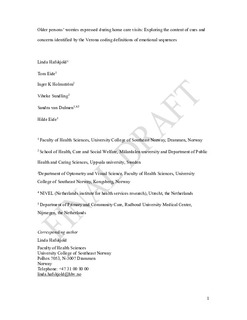| dc.contributor.author | Hafskjold, Linda | |
| dc.contributor.author | Eide, Tom | |
| dc.contributor.author | Holmström, Inger K | |
| dc.contributor.author | Sundling, Vibeke | |
| dc.contributor.author | van Dulmen, Sandra | |
| dc.contributor.author | Eide, Hilde | |
| dc.date.accessioned | 2017-09-05T11:18:01Z | |
| dc.date.available | 2017-09-05T11:18:01Z | |
| dc.date.created | 2016-08-09T12:02:27Z | |
| dc.date.issued | 2016 | |
| dc.identifier.citation | Patient Education and Counseling. 2016, 99 (12), 1955-1963. | nb_NO |
| dc.identifier.issn | 0738-3991 | |
| dc.identifier.uri | http://hdl.handle.net/11250/2453194 | |
| dc.description.abstract | Objective Little is known about how older persons in home care express their concerns. Emotional cues and concerns can be identified by the Verona coding definitions of emotional sequences (VR-CoDES), but the method gives no insight into what causes the distress and the emotions involved. The aims of this study are to explore (1) older persons’ worries and (2) the content of these expressions. Methods An observational exploratory two-step approach was used to investigate audiotaped recordings from 38 Norwegian home care visits with older persons and nurse assistants. First, 206 cues and concerns were identified using VR-CoDES. Second, the content and context of these expressions were analysed inductively. Results Four main categories emerged: worries about relationships with others, worries about health care-related issues, worries about aging and bodily impairment, and life narratives and value issues, with several subcategories showing the causes of worry and emotions involved. Conclusion The two-step approach provides an in-depth knowledge of older persons’ worries, causes of worries, and their related emotions. Practice implications The subcategories described in a language close to the experience can be useful in practice development and communication training for students and health care providers. | nb_NO |
| dc.language.iso | eng | nb_NO |
| dc.title | Older persons’ worries expressed during home care visits: Exploring the content of cues and concerns identified by the Verona coding definitions of emotional sequences | nb_NO |
| dc.type | Journal article | nb_NO |
| dc.type | Peer reviewed | nb_NO |
| dc.description.version | acceptedVersion | nb_NO |
| dc.rights.holder | Copyright © 2016 Elsevier Ireland Ltd. All rights reserved. | nb_NO |
| dc.subject.nsi | VDP::Medical disciplines: 700::Health sciences: 800::Community medicine, Social medicine: 801 | nb_NO |
| dc.source.pagenumber | 1955-1963 | nb_NO |
| dc.source.volume | 99 | nb_NO |
| dc.source.journal | Patient Education and Counseling | nb_NO |
| dc.source.issue | 12 | nb_NO |
| dc.identifier.doi | 10.1016/j.pec.2016.07.015 | |
| dc.identifier.cristin | 1371418 | |
| dc.relation.project | Norges Forskningsråd: 226537 | |
| cristin.unitcode | 222,90,2,0 | |
| cristin.unitcode | 222,90,3,0 | |
| cristin.unitcode | 222,90,1,0 | |
| cristin.unitname | Institutt for radiografi og helseteknologi | |
| cristin.unitname | Institutt for sykepleievitenskap - Drammen | |
| cristin.unitname | Institutt for optometri og synsvitenskap | |
| cristin.ispublished | true | |
| cristin.fulltext | original | |
| cristin.qualitycode | 2 | |
